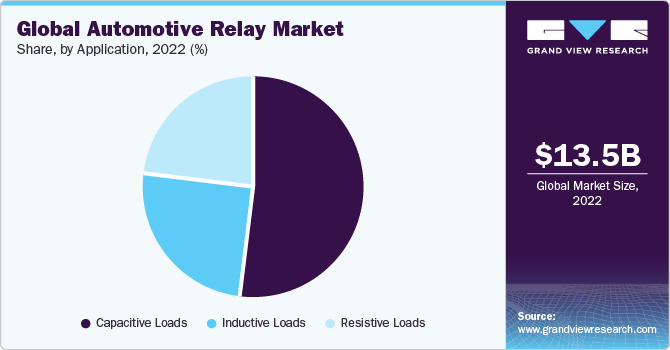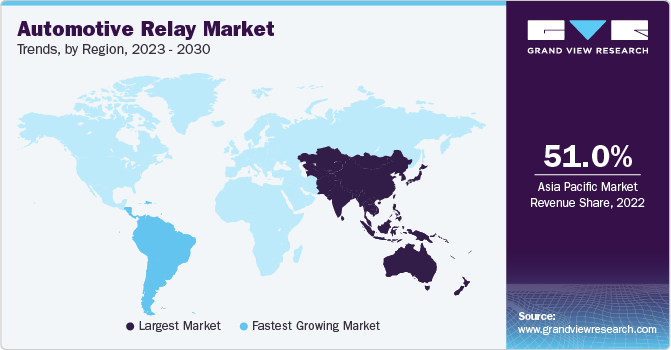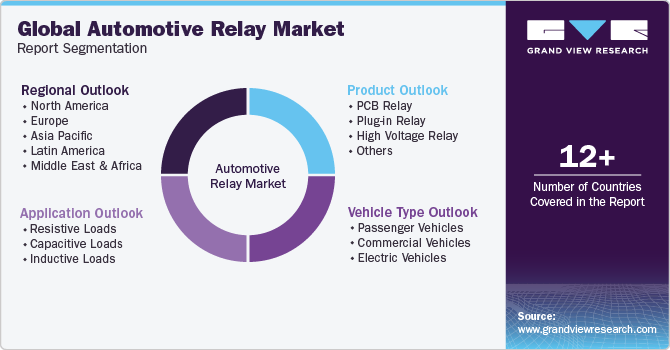
Automotive Relay Market Size, Share & Trends Analysis Report By Product (PCB Relay, Plug-in Relay, High Voltage Relay, Others), By Vehicle Type, By Application (Resistive Loads, Capacitive Loads, Inductive Loads), By Region, And Segment Forecasts, 2023 - 2030
- Report ID: 978-1-68038-305-8
- Number of Report Pages: 180
- Format: PDF, Horizon Databook
- Historical Range: 2017 - 2021
- Forecast Period: 2023 - 2030
- Industry: Technology
Automotive Relay Market Size & Trends
The global automotive relay market size was valued at USD 13.53 billion in 2022 and is expected to grow at a CAGR of 8.1% from 2023 to 2030. Electric automotive parts have diversified over the past decade, leading to an increase in the number of relays used as switching devices and variation in the required features of each relay. The industry is expected to witness steady growth over the forecast period owing to advancements in miniaturization and high contact capability development to address restrictions in mounting space in the Electric Control Unit (ECU) of vehicles.

Electric automotive parts have diversified, thereby increasing the number of relays used for switching; different features are required for each relay. Further miniaturization and high contact capability development are needed, especially in the Electric Control Unit (ECU), where there are restrictions in mounting space due to the presence of a cluster of relays. A high degree of reliability in relays is required from a safety point of view. Components equipped with features such as latching, low noise, and ultra-miniaturization have gained prominence owing to the need to provide switching technology for the latest generation of electronic functions in a car.
The average number of relays installed per vehicle is expected to increase over the forecast period due to the growing adoption of sophisticated electronic equipment and increased emphasis on safety and security. Switching supplementary devices required for safety, security, communications, and infotainment requires additional relays apart from those used in powertrain systems. Increased developments in PCB relays to decrease the overall vehicular weight for increasing fuel efficiency are expected to fill market growth over the forecast period.
With the automotive industry's transition from hardware to software-oriented vehicles, the average number of software and electronics per vehicle is rising rapidly. New features are integrated into vehicles using electronic devices with a wide range of application areas, such as safety management, powertrain, comfort, and infotainment, which employ automotive relays. This is expected to boost the demand in the market during the forecast period.
Passenger safety is another important factor in driving the adoption of automated automobile systems. Vehicle safety features have contributed remarkably to reducing road accidents and fatalities over the last few decades. Also, the automotive industry is working to transform consumers' driving experience. Smarter cars capable of performing self-diagnosis are gaining popularity and are anticipated to augment the market's growth during the forecast period.
The lack of standardization and highly competitive players in relay manufacturing hinder the growth of the global market. During the operation of an automotive relay, large amounts of heat are generated, and other factors, such as durability limitations and switching noise, are expected to hamper the market growth.
The growing demand for hybrid and electric vehicles with advanced, lightweight, and high-performance relays is compelling manufacturers to invest in solid-state relays compared to traditional large electromechanical relays. Thus, this is anticipated to act as an opportunity for the market to grow.
Product Insights
Based on the product, the global market is segmented into PCB relay, plug-in relay, high voltage relay, and others. The PCB relay segment captured the largest revenue share of over 64.7% in 2022 and is expected to grow at the fastest CAGR of 8.4% during the forecast period. It's used in most electronic applications such as ABS, cruise control, doors, power steering, power windows, and sunroof. In regions such as Europe and North America, they are used majorly. However, in regions such as Asia-Oceania and RoW, Tier-1 manufacturers and OEMs still prefer plug-in versions.
Furthermore, the rising demand for electric and hybrid vehicles is driving the growth of PCB relays in the market. These eco-friendly vehicles heavily rely on electronic systems for efficient power management and control. PCB relays are vital vehicle types in electric vehicle charging systems, battery management systems, and motor control units, ensuring these vehicles' safe and reliable operation.
The high voltage relay segment is expected to grow significantly at a CAGR of 8.2% during the forecast period. High voltage relays are also estimated to increase as they have many applications in electric and hybrid electric vehicles. Automotive manufacturers and OEMs integrate the relays in the vehicle’s circuit based on the respective applications. They form tie-ups and alliances with service centers to ensure proper maintenance and replacement of components.
Vehicle Type Insights
Based on vehicle type, the market is segmented into passenger vehicles, commercial vehicles, and electric vehicles. The passenger vehicles segment accounted for the largest revenue share of around 58.7% in 2022. A positive factor responsible for the segment's growth is the increasing demand for electronic e-fuse over electromagnetic alternatives due to the modernization of vehicles. Furthermore, the continuous advancements in automotive technology have led to the integration of sophisticated electronic features and systems in passenger vehicles. Modern passenger vehicles have numerous electronic vehicle types that require reliable and efficient power distribution.
The electric vehicles segment is estimated to register the fastest CAGR of 15.8% over the forecast period.Many European countries follow incentive-based programs for promoting EVs. Countries such as Germany and Austria offer tax exemptions and reductions. France and the U.K. offered bonus payments to EV buyers and discounts on insurance. Governments also provide lucrative offers to promote the selling and usage of EVs. Tax benefits are provided at the time of purchase.
Further, the extent of the exemption depends on the size of the batteries used in the vehicle. For instance, in 2021, Norway implemented a comprehensive package of tax incentives to promote the adoption of zero-emission vehicles (ZEVs). These incentives include exemptions from registration tax, value-added tax (VAT), and motor fuel taxes for ZEVs. Additionally, road taxes, ferry fees, and parking fees for ZEVs have been reduced by at least 50%. These fiscal measures have played a crucial role in driving the demand for ZEVs and increasing their market share in the country's car fleet. Government projections indicate that by 2030, the number of ZEVs in Norway could reach 1.25 million, compared to 225,000 without these incentives.
In the U.S., insurance companies provide discounts on insurance policies to customers, and utility companies offer low electricity rates. In addition, few states offer credits to electric vehicle manufacturers and buyers for their costs and purchase of charging equipment. The Federal Government offers tax credits of up to USD 7,500 for Plug-in Electric Vehicles (PEVs).
Application Insights
Based on application, the market is segmented into resistive loads, capacitive loads, and inductive loads. The capacitive loads segment accounted for the largest revenue share of 52.3% in 2022. Automotive electronics consist of semiconductor devices used to do multiple functions in a car. A car's various safety and comfort systems would not have been possible without electronics. Electronic systems drive some basic applications in modern cars, requiring relays for efficient operation. These include a door lock system, power window, air conditioner, wiper, and fuel injection.
The electronic applications are more in the passenger car than in the LCV segment. This is due to the increasing demand for premium cars with advanced features. Modern vehicles feature a multitude of intelligent systems that increase all safety aspects and driving comforts. Navigation systems with interactive traffic condition interfaces have become common even in mid-sized cars. Passive and active safety systems, such as airbags, belt tensioners, and antiskid brake/traction control, have increased the average number of relays per vehicle.

In high-spec cars, the value of the electric and electronic components sums up to almost a quarter of the total vehicle value. The wiring length can reach several thousand meters with as many connection systems between harnesses, ECU's and actuators. The vehicle's overall reliability is critical for switching lights, motors, heaters, and ECUs.
The resistive loads segment is estimated to register the fastest CAGR of 8.5% over the forecast period. Increasing emphasis on energy efficiency and sustainability in the automotive industry drives the segment growth in the market. Resistive loads, such as LED lighting and energy-efficient climate control systems, are becoming more prevalent in vehicles. As automakers strive to improve fuel efficiency and reduce environmental impact, the demand for relays in resistive load applications is expected to grow.
Regional Insights
Asia Pacific dominated the market and accounted for the largest revenue share of 51.0% in 2022. The market in the Asia Pacific is experiencing significant growth, primarily due to the increasing penetration of automobiles in developing economies like China and the adoption of stringent safety standards in several Asian countries. The region, particularly China and Japan, exhibits a high growth potential driven by the rising vehicle demand. The automotive industry in Asia Pacific is witnessing an upward trend in vehicle demand, expected to drive the regional market's growth throughout the forecast period.
Growing demand for connectivity and car digitalization will favorably impact market growth over the forecast period. Further, due to space constraints, the high-growth potential across the compact car segment has also extensively driven the auto wiring harness demand. Stringent government regulations mandating certain electronic safety systems, such as the Anti-locking Braking System (ABS) and Electronic Stability Program (ESP), to reduce harmful fuel emissions offer avenues for market growth.

South America is expected to register the fastest CAGR of 10.4% over the forecast period. The rise of electric mobility services, such as ride-sharing and car-sharing platforms, is impacting the market for automotive relay in South America. These services have gained popularity in urban centers, offering convenient and environmentally friendly transportation options. As electric mobility services expand their presence in South America, the demand for automotive relays to support their fleet of electric vehicles is projected to grow.
Europe is also expected to grow substantially due to strong automotive sector growth. The leading auto wiring harness market companies include Delphi Automotive, Sumitomo Electric, Furukawa Electric, Tianjin Jin-Zhu Wiring Systems Co. Ltd., Prestolite Electric, Fujikura Ltd., Lear Corporation, and Leoni.
Key Companies & Market Share Insights
The industry players are undertaking strategies such as product launches, acquisitions, and collaborations to increase their global reach. For instance, in April 2023, Fujitsu Limited introduced the FTR-G3 relay, an innovative plastic-sealed relay designed specifically for compact spaces, particularly in automotive applications with limited space. Despite its small size, the FTR-G3 relay can handle high currents of up to 30A, making it highly suitable for Junction boxes and body control units. With the launch of the FTR-G3 relay, Fujitsu expanded its extensive range of automotive relays, further solidifying its position as a leading provider of electromechanical vehicle types. These relays find widespread usage in automotive, industrial, medical, and consumer electronics applications.
Key Automotive Relay Companies:
- ABB
- American Zettler, Inc. (Zettler Components, Inc.)
- BETA ELECTRIC INDUSTRY CO., LTD
- COTO TECHNOLOGY
- Sensata Technologies Holdings N.V
- Deltrol Controls (Deltrol Corporation)
- DENSO CORPORATION
- Eaton
- Fujitsu Limited
- GOOD SKY ELECTRIC CO., LTD.
- IDEC Corporation
- Hella KGaA Hueck & Co. (HELLA)
- Littelfuse Inc.
- LS Automotive Technologies
- Megatone Electronics Corp.
Recent Developments
-
In March 2023, Panasonic Industry Europe GmbH launched its latest relay, the HE-R, which has undergone extensive testing for enhanced short-circuit performance. This relay is designed to provide a reliable and safe solution for electric vehicle (EV) charging industry customers. The HE-R relay has successfully passed the rigorous IEC62955 test, which involves a demanding 10kA short circuit assessment. Furthermore, the smaller HE-S relay complies with the IEC62955 standard for 3kA short circuits.
-
In February 2023, ABB launched the Relay Retrofit Program, which aims to replace specific SPACOM protection relays with advanced REX610 protection and control technology. The all-in-one REX610 relay is specifically designed to accommodate the changing requirements of modern power grids, making it a versatile, environmentally friendly, and future-ready option. The Retrofit Program enables customers to schedule and implement their retrofit projects in stages, ensuring prompt replacement while minimizing disruptions to production or power distribution operations
-
In May 2022, Texas Instruments launched a new range of solid-state relays to enhance the safety of electric vehicles (EVs). This portfolio includes isolated drivers and switches that meet automotive standards, ensuring exceptional reliability. Furthermore, these isolated solid-state relays offer the smallest solution size available in the market, effectively reducing the cost of bill-of-materials (BOM) and powertrain expenses for 800-V battery-management systems.
-
In January 2022, Toshiba Electronics Europe GmbH (TOSHIBA ELECTRONIC DEVICES & STORAGE CORPORATION) launched a novel photo relay designed for various applications in battery-powered and hybrid-electric vehicles. TLX9160T is a normally open (NO) 1-Form-A relay specifically developed for battery management systems (BMS), ground fault detection, and identification of faults with mechanical relays. The TLX9160T can also operate from a supply voltage (VDD) of up to 1000V, making it compatible with most traction batteries commonly used in the industry.
Automotive Relay Market Report Scope
|
Report Attribute |
Details |
|
Market size value in 2023 |
USD 14.50 billion |
|
Revenue forecast in 2030 |
USD 24.97 billion |
|
Growth rate |
CAGR of 8.1% from 2023 to 2030 |
|
Base year for estimation |
2022 |
|
Historical data |
2017 - 2021 |
|
Forecast period |
2023 - 2030 |
|
Report updated |
November 2023 |
|
Quantitative units |
Revenue in USD million/billion, and CAGR from 2023 to 2030 |
|
Report coverage |
Revenue forecast, company ranking, competitive landscape, growth factors, and trends |
|
Segments covered |
Product, vehicle type, application, region |
|
Regional scope |
North America; Europe; Asia Pacific; Latin America; MEA |
|
Country scope |
U.S.; Canada; UK; Germany; France; China; India; Japan; South Korea; Australia; Brazil; Mexico; United Arab Emirates; Saudi Arabia; South Africa |
|
Key companies profiled |
ABB: American Zettler, Inc. (Zettler Components, Inc.); BETA ELECTRIC INDUSTRY CO., LTD; COTO TECHNOLOGY; Sensata Technologies Holdings N.V; Deltrol Controls (Deltrol Corporation); DENSO CORPORATION; Eaton; Fujitsu Limited; GOOD SKY ELECTRIC CO., LTD.; IDEC Corporation; Hella KGaA Hueck & Co. (HELLA); Littelfuse Inc.; LS Automotive Technologies; Megatone Electronics Corp. |
|
Customization scope |
Free report customization (equivalent up to 8 analyst’s working days) with purchase. Addition or alteration to country, regional & segment scope |
|
Pricing and purchase options |
Avail customized purchase options to meet your exact research needs. Explore purchase options |
Global Automotive Relay Market Report Segmentation
This report forecasts revenue growth at global, regional, and country levels and provides an analysis of the latest application trends in each of the sub-segments from 2017 to 2030. For this study, Grand View Research has segmented the global automotive relay market report based on product, vehicle type, application, and region:

-
Product Outlook (Revenue, USD Million, 2017 - 2030)
-
PCB Relay
-
Plug-in Relay
-
High Voltage Relay
-
Others
-
-
Vehicle Type Outlook (Revenue, USD Million, 2017 - 2030)
-
Passenger Vehicles
-
Commercial Vehicles
-
Electric Vehicles
-
-
Application Outlook (Revenue, USD Million, 2017 - 2030)
-
Resistive Loads
-
HVAC
-
-
Capacitive Loads
-
Engine Management Module
-
Fog Lights
-
ABS Module
-
Front and Rear Beam
-
-
Inductive Loads
-
Power Window
-
Central Lock
-
Cooling Fan
-
Clutches
-
-
-
Regional Outlook (Revenue, USD Million, 2017 - 2030)
-
North America
-
U.S.
-
Canada
-
-
Europe
-
UK
-
Germany
-
France
-
-
Asia Pacific
-
China
-
Japan
-
India
-
Australia
-
South Korea
-
-
Latin America
-
Brazil
-
Mexico
-
-
Middle East and Africa
-
United Arab Emirates (UAE)
-
Saudi Arabia
-
South Africa
-
-
Frequently Asked Questions About This Report
b. Asia Pacific dominated the automotive relay market with a share of 51.0% in 2022. This is attributable to the penetration of automobiles in developing economies such as China and India.
b. Some key players operating in the automotive relay market include ABB Group; Denso Corporation; Eaton Corporation plc; Fujitsu Limited; and Hella KGaA Hueck & Co. (HELLA).
b. Key factors that are driving the market growth include increasing adoption of electric vehicles and the growing adoption of vehicular safety technology.
b. The global automotive relay market size was estimated at USD 13.53 billion in 2022 and is expected to reach USD 14.50 billion in 2023.
b. The global automotive relay market is expected to grow at a compound annual growth rate of 8.1% from 2023 to 2030 to reach USD 24.97 billion by 2030.
We are committed towards customer satisfaction, and quality service.
"The quality of research they have done for us has been excellent."




